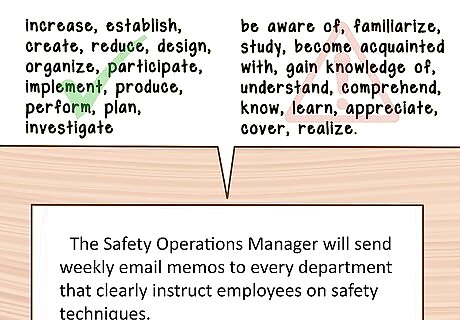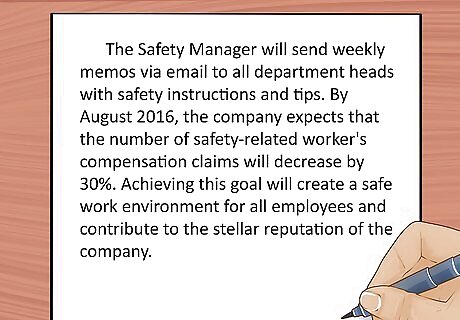
views
Identifying the Objectives

Identify Relevant Performance Objectives. Spend some time thinking about the work that needs to be performed. Sit down, brainstorm and take some notes.Consider what performance outcomes are critical to company success. This usually considers such factors as productivity (amount of work to be performed within a unit of time), cycle time (how long it takes), quality (error rate per std volume), or cost. Pinpoint exactly what a person is expected to do. For example, identify an objective measure such as produce x widgets per hour with 98% pass through rate. Then, zero in on what specific knowledge they need in order to meet that expectation. For example, if an employee is not being as productive as he or she could be, then the data might show that idle time is to blame. Therefore, the solution might be for the employee to work on is or her time management skills. Performance objectives need to be very specific and objective, so look closely at details. Also, make sure that the goals you are setting directly apply to that person’s actual job or position. Is the objective something that the person can manage or change? Confirm that the objective is something that makes sense for a person in their particular role within the organization.

Ensure that results can be measured and achieved. This is not just for you – the people working toward their objectives need to be able to track progress and success, too. Vague objectives can't be properly measured, have no value and can be open to interpretation, which you definitely want to avoid. To prevent this, be certain that there is a way for people to measure their progress. Be prepared to explain in a clear, concise way on paper what this measurement is and how it works. For example, a freshman level botany student whose goal is to understand how plants grow from seed might be expected to raise a tomato plant from seed to fruition. The tomato plant is the measurable outcome. Confirm that the desired outcome for each objective is achievable. One of the primary goals of writing performance objectives for people is to motivate them to succeed. Objectives that include outcomes that the person can't directly influence or change will have the opposite effect. Aim for objectives that will challenge the person in a reasonable way. Pinpoint how the person's individual performance, not external factors, will be the primary determinant in the achievement of the goal. The goals need to be realistic, given the skills of the person in question and resources available. Identify the specific resources and assistance the person will have in achieving the goal.

Communicate performance objectives to employees. Pinpoint what your expectations are then explain them to your employees. Once you’ve identified what your desired outcome is for each objective, you need to be certain that the objective will produce the desired outcome. Explain in a clear and direct way what that outcome actually is. For example, if you plan to ask a marketing associate to complete a monthly newsletter for the company, then you would expect this newsletter to be submitted each month, on a particular day, without fail.

Train employees in proper process. It is important to teach your employees how to achieve the performance objectives using the proper process. Make sure that you explain the proper process to them before the changes are implemented. Consider what type of action must be taken. What will the person need to do in order to achieve the goal? Think about what concepts need to be understood, what types of analysis and tasks they should be capable of, and what kind of problems they need to be able to solve. For example, a new employee who needs to increase productivity will be asked to learn better time management skills. To accomplish this, the employee will attend a webinar each Friday that covers this topic and provides helpful tips.
Confirming Performance Measures with Superiors and Internal Customers

Write report explaining performance objectives. Write a report that explains the performance objectives and how the will be implemented. Include as much detail as possible. You can share this report with your superiors and internal customers. Some ways to make your report as clear as possible include: Use action verbs for each objective. Action verbs are specific to the task and demonstrate exactly what the person needs to do to achieve the objective. Good examples of action verbs are: increase, establish, create, reduce, design, organize, participate, implement, produce, perform, plan, investigate. Avoid vague behavioral verbs. These can be confusing and are usually unable to be accurately measured. Some examples include be aware of, familiarize, study, become acquainted with, gain knowledge of, understand, comprehend, know, learn, appreciate, cover, realize. Written example: The Safety Operations Manager will send weekly email memos to every department that clearly instruct employees on safety techniques.

Explain how the achievement of each goal will be measured. Determine how the person will know when the objective has been completed. For example, the employee who writes memos with safety instructions might be measured based on the number of safety-related worker's compensation claims. Choose goals that have outcomes that can be quantified. Written objective example: The production manager will communicate via email with vendors on a weekly basis to ensure that sufficient quantities of production supplies are on hand at all times. By December 2016, the company expects to experience no shortages in supplies and will measure this by doing a monthly inventory to confirm supply levels.

State the desired outcome clearly. Explain what the desirable result or outcome will be when the person has successfully reached the performance objective goal. For example, if you want an employee with "excellent written communication skills," think about the specific ways those skills will be used. Written objective example: By November 2016, the junior sales associate will create persuasive ad copy that increases sales for the company by 10%. A time frame is given, the job position relates to the task, expectations are clearly stated, and an active verb is used to show what is to be done.

State how performance objectives relate to larger organizational goals. Individual employee objectives should directly relate to the achievement of larger company goals. Individual student goals should relate to the institution's educational objectives. This can provide additional motivation for the person asked to reach them. Written objective example: The Safety Manager will send weekly memos via email to all department heads with safety instructions and tips. By August 2016, the company expects that the number of safety-related worker's compensation claims will decrease by 30%. Achieving this goal will create a safe work environment for all employees and contribute to the stellar reputation of the company. Connecting individual objectives to group goals helps ensure that the performance objectives are relevant and meaningful.
Implementing Performance Measures

Confirm buy-in from appropriate groups. Make sure that everyone who should be aware of the changes is aware of the changes. This includes senior management, supervisors, employees, etc. You might make everyone aware by sending out a memo or email that explains the changes.

Confirm training has been completed and tools are available. Make sure that anyone who is subject to the changes has undergone the appropriate training. You might also check to confirm that everyone has access to information on the changes, such as by providing an informative packet or access to online materials. It might also be a good idea to have someone in charge of confirming that employees have undergone the training, or having employees sign off on having read about the changes.

Consider incentives for performance. To increase the chances that your employees will adhere to the changes, you may consider providing benefits to employees who follow the new procedure. You might also consider penalizing employees who do not follow the new procedure. Benefits might include a pizza lunch at the end of the week if productivity has increased, or even a cash bonus for the highest performing employee. Penalties might include a verbal warning or assigning an unpleasant or boring task to the lowest performer.

Choose a realistic start and end date for each objective. Your target dates should be logical within the context of the objective. Once you’ve identified your time frame, set up a few milestones to be measured along the way. These check points can be motivating and help the person stay on track.



















Comments
0 comment